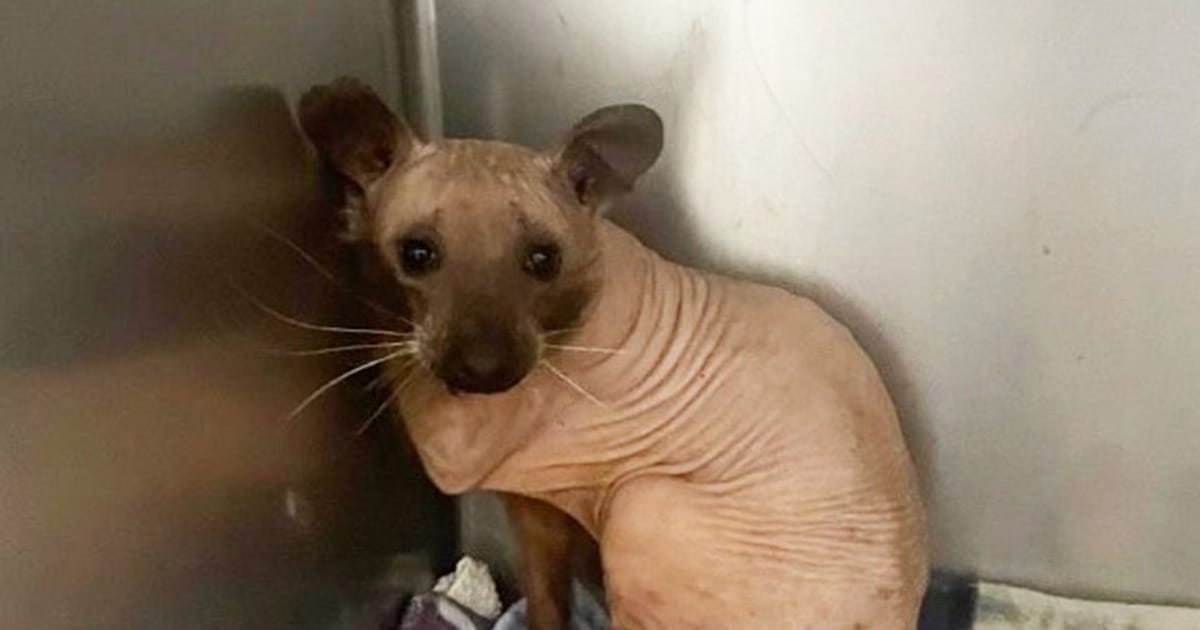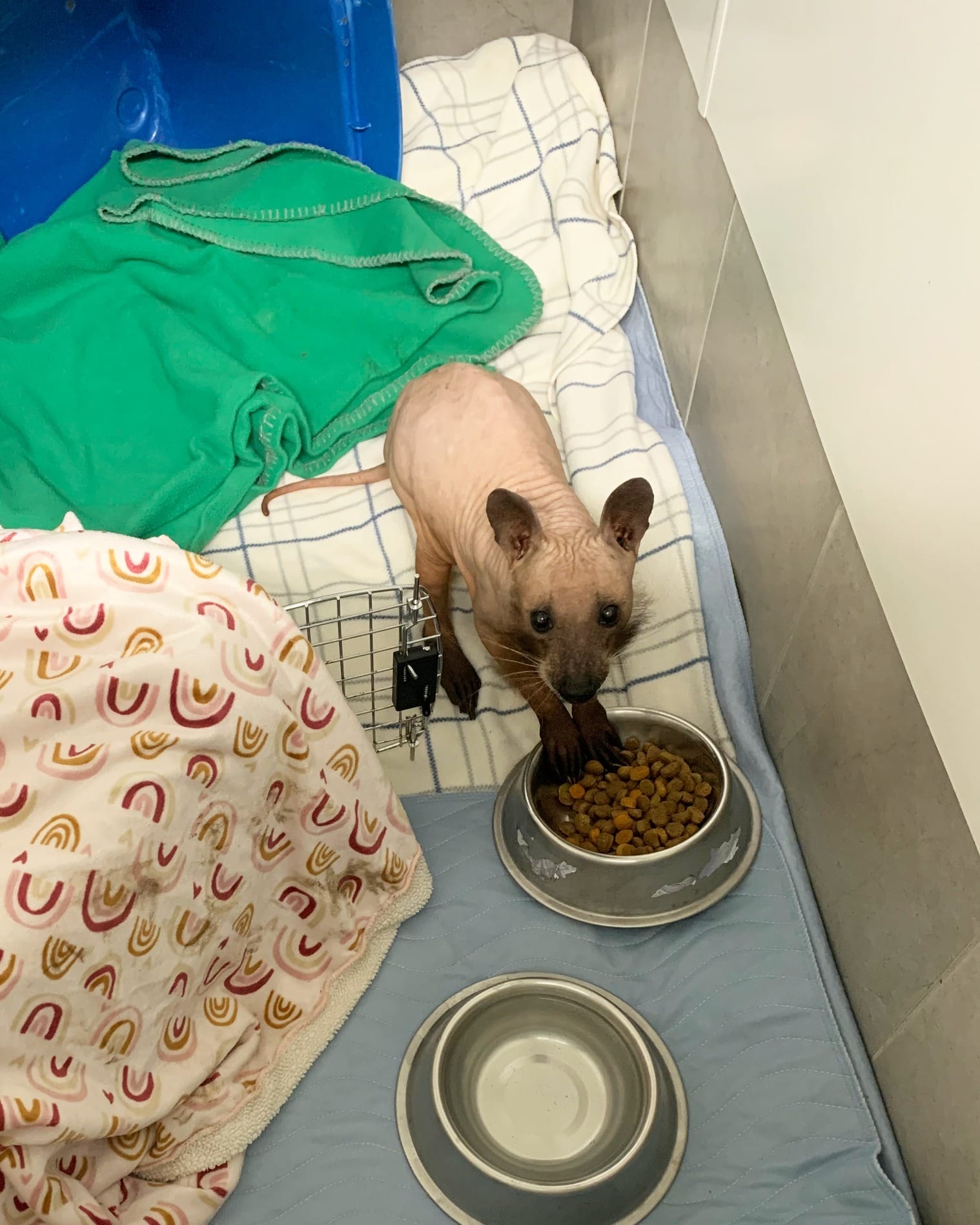
For animals, fur is more than simply a stylish accessory—it keeps them warm in the winter months. It also contributes to their distinct look. However, did you know that some animals could look drastically different when they are completely bald?

After being saved, an amazing creature that seemed like a hairless cat turned out to be an exceptional and unusual hairless raccoon. Let’s explore the tale of this unusual creature and her amazing survival!
Hope for Wildlife, a charitable conservation group based in Nova Scotia, had an unexpected guest last month. During the bitterly cold winter, a couple in West Arichat found a shivering animal in their property. The animal seemed like a Sphynx cat at first, but it was actually a completely bald raccoon!

Without its distinctive fur pattern that resembles a mask, raccoons are difficult to distinguish. This small animal, a northern raccoon, is completely bald as a result of severe alopecia. Although balding raccoons have been seen before, according to Hope for Wildlife director Hope Swinimer, this particular raccoon’s condition was the worst. It’s merely tufts of fur around the feet, ankles, and nose, she said. This situation is serious.
The raccoon was named Rufus, after the character from the show Kim Possible who was a naked mole rat, even though it was a female. The precise reason behind Rufus’ hair loss is still unknown. According to the rescue group, she might have an autoimmune disease that is harming her hair follicles. Since her skin seemed healthy, they ruled out conditions including parasites, mange, and fungal illnesses.

Raccoons depend on their fur to keep warm and shield them from the weather. The fact that Rufus avoided frostbite or worse throughout the hard winter without fur astounded the rescuers.
“We’re pretty amazed that this little lady survived the winter without fur and without getting frostbite or worse,” they gushed on Facebook. They went on to talk about Rufus’ lively attitude and said that her own willpower was the reason she was able to survive. Despite her initial state of debilitation, she eventually began to exhibit indications of recovery, developing resilience and strength.
Rufus might end up staying at the shelter permanently given the conditions. She’ll have a dedicated habitat with an outside area she can crawl into to be warm. In addition, the environment will provide conveniences like nesting boxes and hammocks.
This amazing hairless raccoon has us completely enthralled! We are happy that Rufus was discovered and is finally getting the attention she needs. It’s amazing how she was able to live in the wild for such a long time.Please tell people about this amazing story if you love animals!
Fantastic Appliance with a Stellar Reputation

Past Events
Imagine traveling back in time to the 1950s and 1960s, when rock ‘n’ roll and poodle skirts were popular. It was also a time of clever inventions, such as the old-fashioned electric knife sharpener, which revolutionized our daily cooking procedures. Before the invention of this clever device, sharpening knives required upper-body exercise and involved the use of whetstones or manual sharpeners. But an ordinarily laborious operation was quickly made more convenient and efficient by the electric knife sharpening.
During the post-war boom, when household appliances were all the rage for making life easier, the first models started to light in kitchens. Leading the way were companies like Presto and Chef’s Choice, which produced dependable sharpeners that soon became a fixture in American homes.
Application
Whether you are a novice chef or a seasoned pro, using a vintage electric knife sharpener is simple. Imagine yourself in your kitchen, ready to sharpen those blades to the level of a ninja’s sword after plugging in the sharpener. Here is a brief how-to:
1. Set up: Ensure that the sharpener is spotless and resting on a sturdy base. Turn it on by plugging it in.
2. Sharpening: Align the knife blade with the internal guides as you insert it into the slot. Pull the knife through gradually, applying consistent pressure and speed from heel to tip. The edge will be sharpened and ground by the abrasive wheels inside.
3.Repeating: Do this a few times with duller blades. For varying phases of sharpening, from coarse grinding to delicate honing, many sharpeners have numerous slots.
4. Finishing: Test the blade’s sharpness by slicing through paper or on a cutting surface after wiping off any metal shavings. And voilà! You have a brand-new knife.
History
What, therefore, makes the retro electric knife sharpener a cherished kitchen tool? It all comes down to safety and efficiency. The technique of maintaining knives has been democratized by these devices, making it available to everybody. No more battling with whetstones or making many journeys to the professional sharpener. Not to mention, a sharp knife lowers the possibility of mishaps in the kitchen, making it a safe tool.
These historical pioneers are responsible for the creation of the contemporary models, which are equipped with sophisticated diamond abrasives and precise angle guides. But antique electric knife sharpeners continue to have a unique place in the hearts of people who enjoy a little nostalgia. Not only do they function flawlessly, but they also harken back to a time when inventive solutions for the typical home cook were commonplace.
The old-fashioned electric knife sharpener was, to put it briefly, revolutionary. Its use continues to influence contemporary culinary practices, and its history records an era of remarkable invention. These sharpeners made knife upkeep simple and effective, which made cooking safer and more fun on a daily basis.
So, check it out if you ever come upon one of these antique treasures. Your cooking and your utensils will appreciate it, I promise!



Leave a Reply